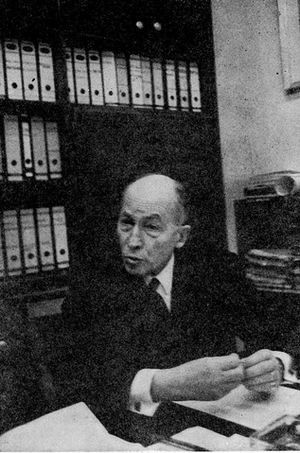 Tomi Ungerer:
Tomi Ungerer:
The Artist and His Background
by chuukyuu (1971)
DRAWING AT THE SPEED OF THOUGHT----------

Iron-Owl
Tomi and his mother returne to her parents' home in Strasbourg.
Tomi was fifteen years old at the time, and his mother wanted him to resume studies so that he could carry on the family profession of running the astronomical clock factory.
His sisters had already married, and the eldest brother, Bernard, was now in college.
Thus Tomi was the only one left who could have possibly continued the traditional trade of the family.
The mother's plan was for Tomi to enter first the Ecole des Decorateurs in Strasbourg, and later to attend an art school in Paris where he could complete the subjects necessary to operate the family business.
Deliberating car fully, she devised the course she wanted him to pursue.
Tomi's interests, however, did not include playing around with machinery.
For him, art, and art alone, was the only path.
No one seems to know exactly why he decided to take up fine art as his lifetime vocation, nor is it known under whom he had up to that time studied his brushwork.
It might be only my imagination, but considering that the members of his family arranged and preserved all the drawings turned out by Tomi during his infancy and boyhood, I think that it probably was they who instigated him on to become an artist, encouraging him whenever he picked up his pen or brush.
Isn't it also quite possible that their irresponsible, yet expedient, words of encouragement struck a deep and responsive chord in the mind of the young boy?
When his mother revealed her plans for him, Tomi answered with finality:
"I have my own personality, my own idiosyncrasies. I have no desire to follow such a regimented course of study."
I have no way of knowing what kind of system of learning Tomi had in mind at that time, but after a series of long discussions, the two of them reached some sort of compromise, the upshot of which was that Tomi took up studies at the Ecole des Decorateurs for the time being.
But here again, his rebellious spirit took flame, the object under attack this time being the antiquated curriculum frosted over with stale authoritarianism. But unlike the spiritual struggle against his sisters or the Nazi regime, in which he had vented his resistance by means of drawings and sketches, his antagonism now was immediate and material.
And perhaps stronger, too, for it boomeranged soon: He wound up being expelled from the school.
 Mr.Francois Herren Schmidt, an architect, remembering Tomi's younger days. (at his office in Rapée street, Strasbourg)
Mr.Francois Herren Schmidt, an architect, remembering Tomi's younger days. (at his office in Rapée street, Strasbourg)
The architect Francois H. Schmidt, father-in-law of Tomi's brother, speaks a little differently about the Tomi of this period. He begins by saying that he first became well acquainted with Tomi after Tomi had reached the age of eighteen.
Before that time, Francois goes on to say, the most he knew about Tomi was that he was expelled from the school in Colmar as a result of his extreme rebellion against the highly regulated school regimentation, a life to which he could not adjust himself.
His mother recalls that the first school Tomi was expelled from was the Ecole des Decorateurs, yet Francois thinks that it was the lycee in Colmar.
This incongruity, however, is of relatively little importance. In time, perhaps', some biographer will trace the devious trail of Tomi's infancy and boyhood, and unravel the tangled threads of all these memories.
Francois further says in regard to Tomi's misdeeds at school:
"The principal of that school was an old man, and a firm believer in discipline. Obviously, Tomi's extraordinary character.and gifted talent were at cross-purposes with such an old man. In fact, Tomi himself became a principal."
Francois laughed when he said this, and then emphasized:
"There wasn't anything Tomi couldn't do. treated him like a professor, and were always after him to learn something from him. To make matters worse, Tomi just couldn't seem to abide" by the school regulations. So a couple of years later, he was kicked out."
To the best of my knowledge, Tomi was about seventeen when he was expelled.
The year before, when he was sixteen, Tomi had taken his first trip outside his native country, going through Switzerland and Germany.
I am not sure if he made that trip during vacation from school, or whether he just got bored with the antiquated courses offered at school and took off on his own.
Nor is it clear what the objective of his travels was-it was sometimes said by way of exaggeration that he wanted to do some more work on geology, one of his favorite studies since early childhood.
Whatever the purpose, he quite likely discovered for himself that outside of his home Alsace there lay a wide, wide world inhabited by all types of people.Another of Francois' remarks deserves special attention, and that is: .. Tomi was as good at dessin as he was at sculpture."
Francois also mentioned that nearly every day after school, Tomi would drop in at his office-apartment on Avenue de Lapaix before returning home. Francois had a high regard for Tomi's innate ability and strongly urged him to become a painter. As Francois himself expressed it, the youthful Tomi "could accomplish almost anything with his own hands, even at that early age."
>>(5)
Art of Montages Part1

Can Hippo

Rat

Ru

Pied De Bourgeois
>>(5)
 トミのティーン・エイジを語る伯父の建築家シュミット氏。(ストラスブール市ラペー通りの事務所で)
トミのティーン・エイジを語る伯父の建築家シュミット氏。(ストラスブール市ラペー通りの事務所で)




